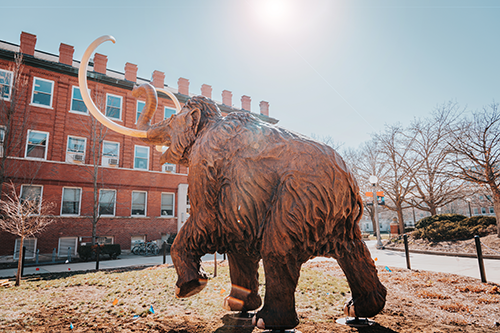

The next, and past, big thing: The great woolly mammoth is back. This time it’s visible to all near the University of Illinois Main Quad.
A new mammoth sculpture is rearing its head on the same ground where real mammoths wandered 30,000 years prior. That’s even older than the neighboring Natural History Building (NHB), built in 1892, from where the sculpture draws inspiration.
Why a mammoth?
Said Erika Lee, U of I Facilities & Services (F&S) interior designer and mammoth project manager: “Because of the nature of the academic activities that take place at NHB, there was interest in artwork that would depict and communicate in a realistic, naturalistic, or even abstract way, an aspect of the geological and biologic history of Illinois.
“In concept, a mammoth sculpture will draw attention to the natural history of Illinois.”
The original proposal for a realistic mammoth was made by Stephen Marshak, professor emeritus of geology in the Department of Earth Science & Environmental Change (formerly geology) and former director of the School of Earth, Society, & Environment (SESE), along with Fred Delcomyn, professor emeritus of molecular and integrative physiology and former director of the School of Integrative Biology (SIB).

“It’s one of the most dramatic animals to live in Illinois,” said Marshak.
“We suggested the mammoth because it reflected the heritage of NHB, which has always been a home for geology and biology, and for many years hosted a Museum of Natural History, which contained casts of mammoth skeletons,” he added. “The point of the sculpture, building on the heritage of NHB, is to convey an aspect of our region’s natural history.”
Seeing it installed on March 20, Marshak said he was delighted.
“The final product is better than we had hoped for,” he said. “It looks artistic, not like a traditional museum diorama. It is scientifically accurate right down to the jaw shape and the toenail color. And it’s certainly eye-catching.”
Marshak noted, “[p]aleontological evidence suggests that mammoths went extinct in Illinois about 13,000 years ago, and were mostly extinct globally by 10,000 years ago. A few isolated populations appear to have survived in the Arctic until 4,000 to 6,000 years ago.”
Art in renovation
The ball for the statue started rolling around 2014, when NHB received a mammoth-sized makeover. Designed by the renowned Nathan Ricker—Illinois alumnus and first architectural graduate in the U.S.—the building underwent a $70 million renovation to transform the interior into a modern learning environment while preserving the architectural details that led to its place on the National Register of Historic Places.
Work restored the building itself, and a small portion of funds was set aside for public art as part of the Art in Architecture (AiA) program.
What’s AiA? From the official Request for Artwork: “The Resolution for an Art in Architecture Policy approved by the University of Illinois Board of Trustees on January 20, 2011, established a policy for all new building and major remodeling projects requiring Board approval, to devote 0.5 percent of the construction budget to securing works of art that shall be placed within public areas at the project site.”

NHB work from 2014 included this AiA component. Each AiA committee typically includes F&S personnel and subject matter experts from associated departments or units. The AiA committee consisted of F&S’ Lee, Marshak, Bob Rauber, professor of atmospheric sciences and director of SESE, and Carla Cáceres, G. William Arends Professor in Integrative Biology and director of SIB.
“Having unique sculptures on campus helps enhance the environments,” said Lee. “Artwork in general should contribute to student pride and appreciation.”
Lee noted other recently installed pieces outside the Medical Science Building and Turner Hall as other examples of AiA-funded art that do a good job of “providing interest and context to the facilities they represent.”
Marshak believes the mammoth is a giant educational opportunity.
“We decided to use the ‘Art in Architecture’ funds in a way that provides a dramatic sculpture, and one that could become a landmark on campus. It is also something that will be a learning experience for students, staff, and the public. It will draw attention to the activities of SESE and SIB in NHB, and to the heritage of the second oldest academic building on campus,” he said.
A few notes on the mammoth
- Taylor Studios, located in nearby Rantoul, won the commission, and they consulted, together with paleontologists and the AiA committee, on details to make the animal realistic. A 3-D model was designed, and, once approved, used to do a scale model using 3-D printing. That provided the template for the full-scale sculpture.
- The statue has a sturdy steel internal skeleton that was bolted to three concrete foundation cylinders that extend three feet below ground level.
- The sculpture’s tusks came from a mold made from real fossilized mammoth tusks.
- The sculptor is Shawn Hensley, and the painter is Angela Norman.
- Do not climb!


